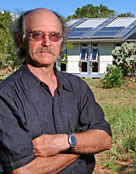Home
Previous Issue
Next Issue
College Home
College Calendar
Aggie Daily
- - - - - - - - - - - - - -
Media contact:
Phillip Rollfing
979.458.0442
email |
| |
| |
New Homes

"Quilting Bee" New Homes In Hurricane-Devastated
Areas
| |
|
Texas A&M University researchers are using a "quilting
bee" approach with other universities and communities across
the Gulf Coast to build new homes for people displaced by Hurricane
Katrina.
"We borrowed ideas derived from the southern art of communal
quilt-making to help us devise building processes and procedures
that fit the
culture of the Gulf Coast," says Pliny Fisk, a Texas A&M
architecture professor. "Our first building using some of
these ideas to help rebuild the area devastated by Katrina started
construction in early December, 2005.
"Quilting new homes using community supported architecture
- we call it CS-Arch - borrows from the concept of community-supported
agriculture, in which farms and communities partner to link production
of food with its consumption," he explains. "CS-Arch
links community volunteers, construction experts and local businesses
to build healthy, locally manufactured housing and other buildings.
Once a set of shared procedures has been created, outcomes of such
cooperative efforts are economical, environmentally friendly and
disaster-safe buildings, resulting in a regionalized building system
using a wide range of natural and human resources."
To quilt communities, Texas A&M's architecture department and
its Center for Housing and Urban Development have joined with the
Austin based Center for Maximum Potential Building Systems Mississippi
State University's architecture department and its Rural Town Center,
the Healthy Building Network, the National Council of Churches,
LZT Architects and EcoRetro Systems to come up with the GroHome
Building System. This system uses a finite system of parts that
can fit together in an infinite number of ways, much like the pieces
of fabric and the patterns of stitching used to make a quilt, and
is based on advanced, fast, economical, healthy building methods
from foundation to roof. Although the proposal has yet to be fully
funded, the finished product would incorporate a wide range of
Texas A&M resources and centers, including the construction
science and landscape architecture departments, the Center for
Hazard Reduction Recovery.
"CS-Arch starts with an inventory of local resources that
can be incorporated into the building process, so manufacturing
methods,
skills and procedures filter economically and strategically into
the community from the outset," says Fisk. "By identifying
and utilizing these resources, relief that is pumped into the region
will continue to circulate locally.
"Next, individual homeowners receive simulation building kits
to help them understand basic building procedures and identify
the
components they need. With the GroHome system, families can start
small and expand their homes as the family grows or when they can
finance more space. Sequential building allows a household to deal
in relatively small financial steps, saving considerable money
while building equity for the next level of financing, an important
consideration for those who have suffered losses in the wake of
natural disasters."
As part of the reconstruction process, Texas A&M and its partners
plan to build a series of pre-fabricated community based manufacturing
centers to house several scales of production, from complete pre-fabricated
homes to small, easily manageable, do-it-yourself building components.
However, the GroHome procedure also can be designed to diversify
manufacturing beyond the usual modular building system where fabrication
occurs under one roof. A set of simple protocols is provided for
components to ensure compatibility and performance and enable use
of a broad range of building materials and methods. This system
of shared structural, thermal and dimensional performance standards
allows for a flexible manufacturing network where each shop and
trade operates autonomously, so that a number of manufacturers
can participate within any region, quickening response and improving
the quantity of delivered homes.
"Our first manufacturing center is being started in Jackson,
Mississippi," Fisk
says. "Part of CS-Arch involves carefully building relationships
with local industries so that centers complement, rather than compete
with, area businesses."
Although CS-Arch uses local resources whenever possible, it also
depends on bringing in experts in issues of toxicology, evidence-based
economic design, energy and manufacturing efficiency, and cooperating
with citizens.
"Reconstruction of areas devastated by natural disasters offers
a fantastic opportunity to use both human and natural resources
to the fullest," Fisk says. "In the Gulf Coast, CS-Arch
is poised to rebuild a healthy landscape, bio-remediate toxicity
and provide management practices to enable nature to continue doing
her work. Such an approach will ensure that sustainability becomes
embedded in future development."
| |
 Pliny Fisk
Pliny Fisk
|
|
| |
|
|

